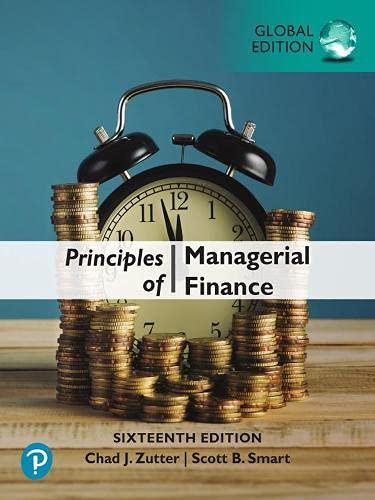Answered step by step
Verified Expert Solution
Question
1 Approved Answer
based on this slide above answered the question on the following slide below DIVIDEND DISCOUNT MODELS - Exercise Confirm that the intrinsic value of Honda




based on this slide above answered the question on the following slide below

DIVIDEND DISCOUNT MODELS - Exercise Confirm that the intrinsic value of Honda using the same data as in our example, but assuming its beta is 1, is $23.53. Hint: First calculate the discount rate and stock price in 2015. Then calculate the present value of all interim dividends plus the present value of the 2015 sales price.) Example Value Line provides explicit dividend forecasts over the relative short term, with dividends rising from $.72 in 2012 to $1 in 2015 . We can obtain dividend inputs for this initial period by using the explicit forecasts for 2012-2015 and linear interpolation for the years berween: Now let us assume the dividend growth rate will be steady beyond 2015. What is a reasonable guess for that steady-state growth rate? Value Line forcasts a dividend payout ratio of 25 and an ROE of 1096 , implying long-term growth will be g=ROEb=10%(1.25)=7.5% Our estimate of Honda's intrinsic value using an investment horizon of 2015 is therefore obtained from Equation 13.2, which we restate here: V2011=(1+k)D2012+(1+k)2D2013+(1+k)3D2014+(1+k)4D2ons+P2015=(1+k).72+(1+k)2.81+(1+k)3.90+(1+k)41.00+Pman3 Here, P3013 represents the forccast price at which we can sell our shares of Honda at the end of 2015, when dividends enter their constant-growth phase. That price, aceording to the constant-growth DDM, should be DIVIDEND DISCOUNT MODELS - LIFE CYCLES AND MULTISTAGE GROWTH MODELS - Example (Continued) Psots=kgDmotk=kgDans(1+)=k.0751.001.075 The only variable remaining to be determined to calculate intrinsic value is the market capitalization rate, k One way to obtain k is from the CAPM. Observe from the Value Line data that Honda's beta is .90 . The risk-free rate on long-term T-bonds in late 2011 was about 2.99. 5 Suppose that the market risk premium were forecast at 8%, roughly in line with its historical average. This would imply that the forecast for the market return was Risk-freerate+Marketriskpremium=2.9%+8%=10.9% Therefore, we can solve for the market capitalization rate for Honda as E=rf+[E(rM)rf]=2.9%+.90(10.92.9)=10.1% Our forecast for the stock price in 2015 is thus P2015=.101.075$1.001.075=$41.35 and today's estimate of intrinsic value is V2011=1.101.72+(1.101)2.81+(1.101)3.90+(1.101)41.00+41.35=$30.81 We know from the Value Line report that Honda's actual price was $29.54 (at the circled B). Our intrinsic value analysis indicates Honda was underpriced by about 4.196. Should we increase our holdings of Honda stock? Confirm that the intrinsic value of Honda using the same data as in our example, but assuming its beta is 1, is $23.53. (Hint: First calculate the discount rate and stock price in 2015. Then calculate the present value of all interim dividends plus the present value of the 2015 sales price.) Value Line provides explicit dividend forecasts over the relative short term, with dividendis rising from $.72 in 2012 to $1 in 2015 . We can obtain dividend inputs for this initial period by using the explicit forecasts for 2012-2015 and linear interpolation for the years between: Now let us assume the dividend growth rate will be steady beyond 2015 . What is a reasonable guess for that steady-state growth rate? Value Line forecasts a dividend payout ratio of 25 and an ROE of 1096 , implying long-term growth will be g=ROEb=10%(1.25)=7.5% Our estimate of Honda's intrinsic value using an investment horizon of 2015 is therefore obtained from Equation 13.2, which we restate here: V2011=(1+k)Dmo12+(1+k)2D2013+(1+k)3Dzont+(1+k)4Dzons+P2o1s=(1+k).72+(1+k)2.81+(1+k)3.90+(1+k)41.00+Ptons Here, P2013 represents the forecast price at which we can sell our shares of Honda at the end of 2015 , when dividends enter their constant-growth phase. That price, according to the constant-growth DDM, should be DIVIDEND DISCOUNT MODELS - LIFE CYCLES AND MULTISTAGE GROWTH MODELS - Example (Continued) Psons=kgD2016=kgD2015(1+g)=k.0751.001.075 The only variable remaining to be determined to calculate intrinsic value is che market capitalization rate, k. One way to obtain k is from the CAPM. Observe from the Value Line data that Hondr's beta is .90 . The risk-free rate on long-term T-bonds in late 2011 was about 2.996 .530 . Suppose that the market risk premium were forecast at 89 , roughly in line with its historical average. This would imply that the forecast for the market return was Risk-freerate+Marketriskpremium=2.9%+8%=10.9% Therefore, we can solve for the market capitalization rate for Honda as E=rj+[E(rM)rj]=2.9%+.90(10.92.9)=10.1% Our forecast for the stock price in 2015 is thus P2015=.101.075$1.001.075$41.35 and today's estimate of intrinsic value is Vzon1=1.101.72+(1.101)2.81+(1.101)3.90+(1.101)41.00+41.35=$30.81 We know from the Value Line report that Honda's actual price was $29.54 (at the circled B). Our intrinsic value analysis indicates Honda was underpriced by about 4.196. Should we increase our holdings of Honda stock? Confirm that the intrinsic value of Honda using the same data as in our example, but assuming its beta is 1 , is $23.53. (Hint: Fist calculate the discount rate and stock price in 2015. Then calculate the present value of all interim dividends plus the present value of the 2015 sales price.)
Step by Step Solution
There are 3 Steps involved in it
Step: 1

Get Instant Access to Expert-Tailored Solutions
See step-by-step solutions with expert insights and AI powered tools for academic success
Step: 2

Step: 3

Ace Your Homework with AI
Get the answers you need in no time with our AI-driven, step-by-step assistance
Get Started


